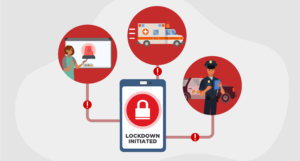In their report, Ten Essential Actions to Improve Safety, the U.S. Department of Justice (DOJ) Office of Community Oriented Policing Services (COPS) School Safety Working Group shared 10 things schools can do from a law enforcement perspective to mitigate and prevent school violence.
The report recommends schools take a balanced, holistic, and robust approach to school safety that involves multidisciplinary planning and implementation. School officials, law enforcement, mental health professionals, and other appropriate personnel should be involved in developing the safety and security plans so all voices in the school community are recognized. The report further suggests that school administrators, teachers, students, parents, nurses, school resource officers (SROs), and other school personnel have a means to communicate their concerns and suggestions to address school safety needs.
The ten essential actions are summarized below. Read the full report here.
1. Comprehensive School Safety Assessment
The school safety assessment, which should be developed by an interagency, multidisciplinary team, identifies the highest probability threats, their potential consequences, and the school or school districts vulnerabilities to those threats. As the foundation for all safety planning and operations, it is important to review, and if necessary, update the document annually based on changes to school policy or feedback from stakeholders.
Many school safety plans fail to include important components like emergency mass notification; family reunification; monitoring and managing information shared with the media; identifying mental health professionals before an incident; and the possibility of contagion following a student suicide or mass casualty attack.
There are many free resources available to help with these assessments, including those offered by Readiness and Emergency Management for Schools and Safe and Sound Schools.
2. School Climate
Noting that isolation and detachment are common traits of school shooters, the report urges schools to create a positive campus environment that promotes respectful relationships and open communication. Students are more likely to ask for help or report concerns if they have a positive connection with staff and teachers. Schools can implement a positive environment by implementing violence and bullying prevention programs; training staff, students, and parents to recognize indicators of potential violence, suicide, and self-harm; and having social emotional learning programs and bystander intervention training.
3. Campus, Building, and Classroom Security
With many security options, equipment, and technology available, it can be difficult for districts and schools to identify what exactly they need. There is no one-size-fits-all solution so it is recommended that schools start with an assessment to identify gaps in their security. Students should be given the opportunity to rank the vulnerabilities, offer solutions, and provide overall input to the assessment. Once the gaps are identified, districts can plan for acquiring and deploying the technology and equipment on their campuses. At a minimum, schools should have:
- Building and classroom numbering systems or other methods for clearly identifying locations
- Classroom doors that can be locked from the inside or remotely
- Removable window and door glass coverings
- Secure, uncluttered safe spaces called hard corners in every classroom
- Access control systems and video surveillance
Other equipment and technology to consider include:
- Silent panic alarms (some states require panic alarms in each building per Alyssas Law)
- Emergency two-way communications with all classrooms, offices, and large capacity spaces (gyms, cafeterias, locker rooms, outdoor areas)
- Automated external defibrillators (AED) and stop-the-bleed kits
- A radio repeater
COPS and the Bureau of Justice Assistance offer funding for schools to improve security with the above mentioned technology as well as others, like visitor management and emergency management systems.
4. Anonymous Reporting Systems
Proven to be effective in identifying and communicating potential targeted violence and suicidal threats, anonymous reporting systems allow users to alert officials of potential threats or concerns. The most successful systems educate the school community on potential indicators and how to share their concerns so officials can intervene before an incident happens. Anonymous reporting systems must have robust tracking and accountability measures, and COPS recommends that state and local school-based systems integrate with the national Averted School Violence (ASV) database. ASV identifies and studies incidents of school violence that were prevented to determine what factors led school officials and law enforcement to successfully intervene.
5. Coordination with First Responders
Responding to a critical incident like a school shooter will heavily involve 9-1-1, local law enforcement, and emergency medical services. Advanced planning and joint training are critical to ensure an effective and rapid response. COPS recommends that coordination between schools and law enforcement begin with the safety assessment and flow through the development of policies and the emergency operations plan to training, ongoing drills and periodic evaluation.
Key considerations include:
- Joint training between first responders and school officials
- Numbering buildings and ensuring immediate access to school buildings
- Performing walkthroughs and providing access to building floor plans
- Providing schools with a two-way radio directly linked to the local public safety answering point
- Coordinate how to communicate with the public through press conferences and social media
- Work together with school officials and first responders to ensure rapid transportation of the injured, accounting for individuals who were present, interviewing witnesses, and initiating victim-witness assistance
A mobile panic alert system, like Raptor Alert, can greatly expedite awareness and response by enabling all teachers and staff to quickly summon help and send detailed, situation-specific alerts to a custom list of recipients, including the school community, district administrators, and multiple first responder agencies, from wherever they are on campus. Raptor Alert is customizable to your schools emergency protocols and allows users to quickly connect to 9-1-1, share their locations, stay updated through real-time group messaging, and share emergency documents including highly-detailed maps and floorplanswith first responders.
Raptor Alert is a component of Raptor Emergency Management, a trusted system that gives you full line of sight to everyone and every incident in your schools. The system empowers teachers and staff to account for themselves as well as everyone else on campus students, visitors, guardians, and contractors immediately after the panic alert is initiated. Raptor also streamlines reunification and is proven 4x faster than paper-and-pencil based methods.
6. Behavior Threat Assessment and Management
Receiving information about threats, although incredibly important, is only the first step in a three-step process. Trained members of a multidisciplinary team of professionals, including teachers, administrators, SROs or a selected local law enforcement officer, and mental health professionals, should assess and manage each threat. The team should thoroughly evaluate the threat, corroborate the information, and develop a plan to manage the threat.
7. School-Based Law Enforcement
SROs and school safety officers (SSO) are the best school personnel positioned to respond to emergencies. An active partnership between schools and law enforcement is vital to school safety.
For schools who do not have the resources to place an SRO at each school, there are options that districts and individual schools can consider, including:
- Signing a memorandum of understanding (MOU) with local law enforcement agencies to clearly define roles, responsibilities, and expectations for both the school and the agency as well as its officers
- Contracting with local and state law enforcement agencies for off-duty officers
- Establishing a substation at the school for local and state law enforcement officers to use for breaks, report writing, and meeting with students and families around school-related issues
- Hiring retired law enforcement officers as school employees or through a contract
- Contracting with a private security company to provide armed or unarmed security officers
8. Mental Health Resources
Schools have the potential to play a key role in preventing youth mental, emotional, and behavioral difficulties; identifying and supporting students with mental health problems; and reducing youth violence, according to the report. Schools need access to counselors, psychologists, social workers, and other mental health professionals who can identify problems, intervene, and provide treatment. Schools should also build relationships with community-based and local government social service providers who can assist students with intensive mental health needs.
9. Drills
Conducting drills helps your teachers, students, and staff be prepared so they can confidently respond and keep everyone safe in an actual crisis. The report highlights the importance of building muscle memory and clear expectations of everyone’s roles by conducting drills as required by your states laws throughout the year. Schools should have debrief sessions after each drill to identify areas of improvement.
Managing drills across an entire district can be a logistical challenge, especially during a busy school year. Raptor Drill Manager makes scheduling, conducting, and reporting on drills faster and easier for both school and district administrators. With Raptor, you can make certain that no school in your district ever misses another drill.
10. Social Media Monitoring
Monitoring social media can help schools intervene before an incident happens. Although most social media posts are harmless, students sometimes communicate their intent to hurt others or themselves, and cyberbullying, which 34% of youths have experienced, according to the report, has been associated with victim self-harm or retaliation
By considering these ten essential actions and implementing trusted, proven solutions schools can establish a comprehensive, multilayered approach to school safety. Raptor is the nations leading provider of integrated school safety solutions and is trusted by over 35,000 K-12 U.S. schools. To learn more, contact us today to set up a personalized demo.



